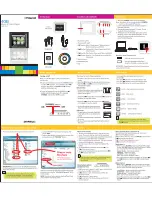
DMR |
11
dhcp=(bool)
0
dns_1=(string)
192.168.0.2
dns_2=(string)
192.168.0.3
ethernet=(string)
auto
gateway=(string)
192.168.1.1
ipaddress=(string)
192.168.1.253
netmask=(string)
255.255.255.0
If the dmx_ip_conf.txt file is intentionally
left blank with no text of any type within
the body of the file, the DMR will write
its network settings to this file. This is
an easy way to obtain the unit’s network
settings.
SMTP Mail
The DMR has the ability to send email messages to a
remote SMTP server. Enter the address of the SMTP
server in the appropriate text box (use the IP address if
DNS settings are not set). The Email field will set the
default “From” field to the entered email. Leave this
field blank to allow the user to enter their own “From”
email address. Confirm any changes to the SMTP mail
configuration by clicking Save SMTP settings button.
Command Line
The DMR has a Command Line interface that can be
accessed from Telnet or RS-232. A list of commands can
be found in the External Control section of this manual.
Telnet (TCP/IP)
The Telnet port by default is not enabled. To turn on
Telnet control, set the Telnet port number (typically
Port 23) and check the TCP/IP port enable checkbox.
A password for the Telnet session can be activated
by entering a password in the Password for TCP/IP
connection text box. If a password is not desired on the
Telnet session, leave the text box blank.
RS-232
On the back of the DMR there is a serial control port
configured as a DTE that supports the RS-232 protocol. A
Null-Modem cable should be used between the DMR and
the COM port on your PC.
Terminal session settings required for RS-232 control
are: 9600, 8, None, 1 with No Flow Control.
There is no password protection on this interface
and, by default the RS-232 port is enabled. The
administrator has the ability to disable the port by un-
checking the COM port enable checkbox.
















































